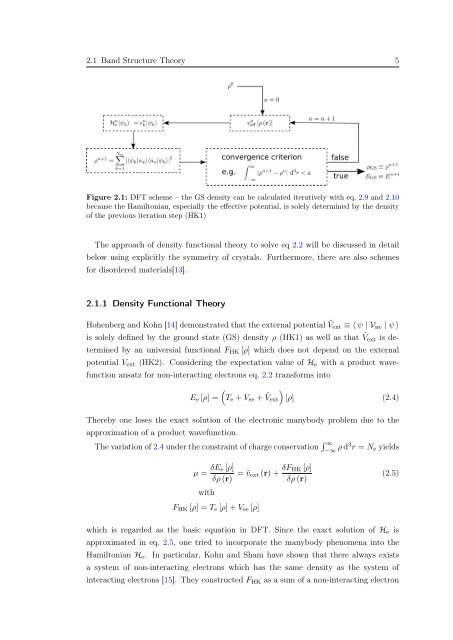Diploma - Max Planck Institute for Solid State Research
Diploma - Max Planck Institute for Solid State Research
Diploma - Max Planck Institute for Solid State Research
Create successful ePaper yourself
Turn your PDF publications into a flip-book with our unique Google optimized e-Paper software.
2.1 Band Structure Theory 5<br />
Figure 2.1: DFT scheme – the GS density can be calculated iteratively with eq. 2.9 and 2.10<br />
because the Hamiltonian, especially the effective potential, is solely determined by the density<br />
of the previous iteration step (HK1)<br />
The approach of density functional theory to solve eq 2.2 will be discussed in detail<br />
below using explicitly the symmetry of crystals. Furthermore, there are also schemes<br />
<strong>for</strong> disordered materials[13].<br />
2.1.1 Density Functional Theory<br />
Hohenberg and Kohn [14] demonstrated that the external potential Ṽext ≡ 〈 ψ | V ne | ψ 〉<br />
is solely defined by the ground state (GS) density ρ (HK1) as well as that Ṽext is determined<br />
by an universial functional F HK [ρ] which does not depend on the external<br />
potential V ext (HK2). Considering the expectation value of H e with a product wavefunction<br />
ansatz <strong>for</strong> non-interacting electrons eq. 2.2 trans<strong>for</strong>ms into<br />
E e [ρ] =<br />
(<br />
)<br />
T e + V ee + Ṽext [ρ] (2.4)<br />
Thereby one loses the exact solution of the electronic manybody problem due to the<br />
approximation of a product wavefunction.<br />
The variation of 2.4 under the constraint of charge conservation ∫ ∞<br />
−∞ ρ d3 r = N e yields<br />
µ = δE e [ρ]<br />
δρ (r) = ṽ ext (r) + δF HK [ρ]<br />
δρ (r)<br />
with<br />
F HK [ρ] = T e [ρ] + V ee [ρ]<br />
(2.5)<br />
which is regarded as the basic equation in DFT. Since the exact solution of H e is<br />
approximated in eq. 2.5, one tried to incorporate the manybody phenomena into the<br />
Hamiltonian H e . In particular, Kohn and Sham have shown that there always exists<br />
a system of non-interacting electrons which has the same density as the system of<br />
interacting electrons [15]. They constructed F HK as a sum of a non-interacting electron
















